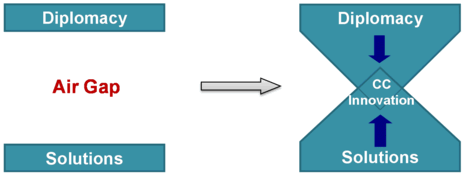Climate Change Diplomacy (2008)
Rapid progress in tackling climate change requires innovation both in solutions and diplomacy.

See our case study on innovation in Climate Change Diplomacy ![]() (0.5MB), as presented in Malta.
(0.5MB), as presented in Malta.
The topic was discussed at the International Conference on Climate Change Diplomacy, Malta, 7-8 February 2008, organised by DiploFoundation ![]() .
.
- All sessions were on climate change diplomacy and covered:
- What's different
- A multi-stakeholder approach
- Regional perspectives
- Building Capacity (see conference programme and presentations).
Case Study: Innovation in Climate Change Diplomacy
Rapid progress in tackling climate change requires innovation both in solutions and diplomacy
IMERS innovation case study ![]() (0.5MB presentation)
(0.5MB presentation)
This case study shows how diverse and conflicting positions in climate change negotiations can be addressed successfully through simultaneous innovation in solutions and the diplomatic process. The potential for synergies is enormous as many officials are constrained by bureaucracy and time, and often lack the vision and skills that business innovators can bring.
We describe how novel thinking and non-state actors have managed to unlock one of the most methodologically complex and diplomatically difficult issues. Emissions from international aviation and maritime transport had to be excluded from the Kyoto Protocol in 1997 and little progress has been achieved since then.
In early 2007 we created an ambitious International Maritime Emission Reduction Scheme (IMERS). It is a novel market-based scheme to mitigate maritime CO2 emissions and simultaneously reduce the gap in financing of adaptation to climate change in developing countries by $3bn annually (from 2010, assuming 2005 emission goal). Within just one year it was brought to the International Maritime Organization (IMO), discussed internationally and followed by practical submissions from various states and organizations. We will discuss how this swift progress was possible, what issues have been unlocked, and what remains to be done for the proposed scheme to be agreed and implemented.
Our experiences show that bringing novel solutions by non-state actors to diplomatic negotiations requires business rigour and diplomatic patience, as well as money - obtaining funding for a public good solution is rather difficult!
Based on our experiences, we find that successful innovation in climate change diplomacy involves three crucial steps:
- Craft an ambitious yet affordable solution. Do it by following best practices in business strategy, thereby avoiding governmental or other policy constraints.
- Bring the proposal to the multilateral process through an influential government. Ignore the temptation to try to achieve this through associations or large companies, it might take years.
- Engage relevant parties in an iterative process aimed at refining and ultimately supporting the proposed solution. Select diverse parties for initial discussions - obtaining support from the 27 EU countries is well short of what is required in climate change diplomacy. Formalize this iterative process within the multilateral organization and engage business innovators in the process.
The case study ends with an open discussion drawing on the key lessons learned. Example quotes from informal discussions in 2007 to enrich the debate:
- I've only 2 hrs per week for this topic.
- Why us? Why not country XYZ?
- After so many years of deadlock I don't even remember what's the issue anymore
- Seems like a great proposal. But, it might be incompatible with our policy.
- Q: What's your policy?
- A: We don't have one yet.
- Our experts are uncomfortable.
- Q: What about?
- A: I don't know yet.
